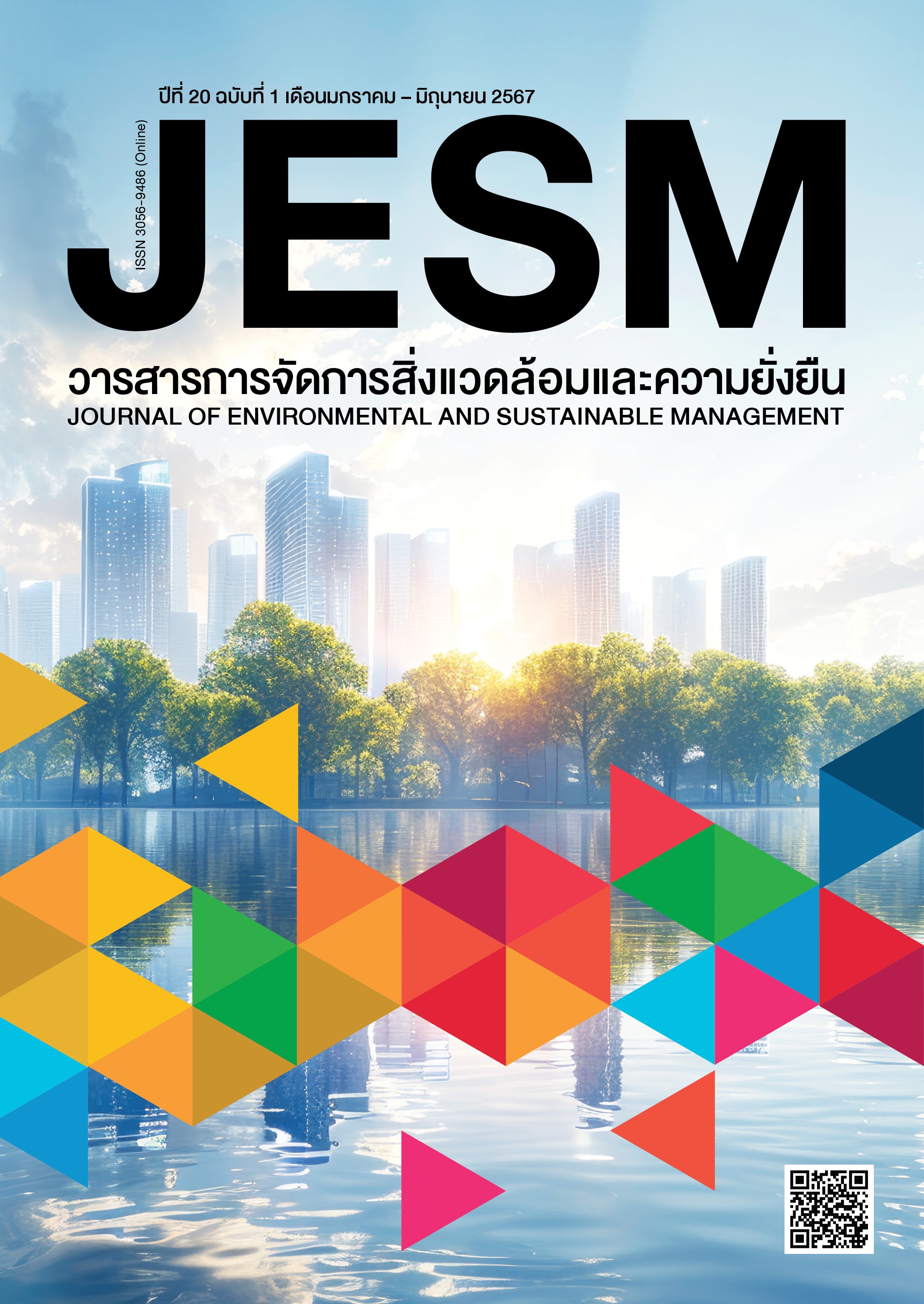การศึกษาเปรียบเทียบการใช้มาตรการทางกฎหมายสำหรับการคัดแยกขยะที่ต้นทางในกรุงเทพมหานคร
DOI:
https://doi.org/10.14456/jesm.2024.1คำสำคัญ:
กฎหมายคัดแยกขยะ, การคัดแยกขยะ, การจัดการขยะมูลฝอย, กรุงเทพมหานครบทคัดย่อ
บทความนี้มีวัตถุประสงค์เพื่อศึกษาเปรียบเทียบการใช้กฎหมายลดและคัดแยกขยะของประเทศไทยกับประเทศในภูมิภาคเอเชียประกอบด้วยประเทศจีน ญี่ปุ่น สิงคโปร์ และประเทศเกาหลีใต้ และเสนอประเด็นที่ควรกำหนดในกฎหมายลดและคัดแยกขยะของกรุงเทพมหานครโดยใช้วิธีการวิจัยเชิงคุณภาพ เก็บรวบรวมข้อมูลจากเอกสาร การสัมภาษณ์ และการสนทนากลุ่ม วิเคราะห์ข้อมูลด้วยวิธีวิเคราะห์เนื้อหา วิเคราะห์เปรียบเทียบ และวิเคราะห์บริบทของกรุงเทพมหานคร ผลการศึกษาพบว่าประเทศที่ศึกษามีกฎหมายกำหนดประเภทขยะที่ต้องคัดแยกชัดเจน มีโครงสร้างพื้นฐานรองรับการคัดแยกขยะ โดยประเทศไทยกำหนดแยกขยะบางประเภท ไม่มีกฎหมายเฉพาะ ให้อำนาจราชการส่วนท้องถิ่นออกข้อบัญญัติกำหนดประเภทขยะ และการจัดให้มีโครงสร้างพื้นฐานรองรับการคัดแยกขยะ กรุงเทพมหานครมีจุดแข็งจากนโยบายและแผนส่งเสริมการลดและคัดแยกขยะ มีอำนาจออกข้อบัญญัติ จัดสรรงบประมาณ และบุคลากร แต่ยังมีจุดอ่อนในแง่ของการพัฒนาบุคลากร การจัดสรรงบประมาณสนับสนุนการพัฒนาโครงสร้างพื้นฐาน มีนโยบายและแผนของรัฐบาลที่สนับสนุนการลดและคัดแยกขยะ แต่ก็ยังมีอุปสรรคจากการขาดความเชื่อมั่นต่อระบบการจัดเก็บขยะแยกประเภท และ วัฒนธรรมการทิ้งขยะรวมของประชาชน กรุงเทพมหานครควรออกข้อบัญญัติกำหนดให้แยกขยะ 9 ประเภท พร้อมจัดให้มีโครงสร้างพื้นฐานรองรับการคัดแยกขยะ สื่อสารสร้างการรับรู้แก่ประชาชนทั่วไป และบังคับใช้กฎหมายอย่างจริงจัง
เอกสารอ้างอิง
BMA Strategy and Evaluation Department. (2018). The 20-year Development Plan for Bangkok Metropolis 2021-2037. [In Thai]. Bangkok: Strategy and Evaluation Department. Revised edition. Retrieved June 12, 2021, from https://officialadmin.bangkok.go.th/upload/file_tcqXHcotAB_145748.pdf.
BMA Environment Department. (2021). Sathiti Khomun Ongprakop Munfoi Thang Kaiyaphap Pracham Pi-ngoppraman 2564 [in Thai]. Retrieved from https://webportal.bangkok.go.th/public/user_files_editor/231/WasteData/2565/WasteComp_2.pdf.
BMA Environment Department. (2021). Bangkok State of Environment 2019 -2020 [In Thai]. Bangkok: Akson Thai Printing Ltd., Part.
Bush, T. (2019). Internal and External Analysis in Strategic Management (SWOT and PESTLE). Retrieved July 2, 2022, from https://pestleanalysis.com/internal-and-external-analysisin-strategic-management/
Edyvean, R. G., Apiwatanapiwat, W., Vaithanomsat, P., Boondaeng, A., Janchai, P., & Sophonthammaphat, S. (2023). The Bio-Circular Green Economy model in Thailand–A comparative review. Agriculture and Natural Resources, 57(1), 51-64.
Food and Agriculture Organization of the United Nations. (2020). Law of the People’s Republic of China on the Prevention and Control of Environment Pollution Caused by Solid Wastes (2020). Retrieved December 17, 2021 ,from https://www.fao.org/faolex/results/details/en/c/LEX-FAOC154880.
Fei, F., Kosajan, V., Shen, N., & Luo, J. (2022). Promoting the source separation of household kitchen waste based on comprehensive evaluation and economic feasibility. Journal of Cleaner Production, 130970.
Green Initiatives. (2020). ONE YEAR OF WASTE SEGREGATION IN SHANGHAI: SUCCESS OR FAILURE?. Retrieved December 11, 2022, from https://greeninitiatives.cn/one-yearof-waste-segregation-in-shanghai-success-or-failure/.
Knickmeyer, D. (2020). Social factors influencing household waste separation: A literature review on good practices to improve the recycling performance of urban areas. Journal of cleaner production, 245, 118605.
Ministry of Commerce. (2013). Packaging products in the Japanese market. Retrieved September 18, 2022, from https://www.ditp.go.th/contents_attach/91394/91394.pdf.
Ma, Y., Wang, H., & Kong, R. (2020). The effect of policy instruments on rural households’ solid waste separation behavior and the mediation of perceived value using SEM. Environmental science and pollution research, 27, 19398-19409.
National Environmental Agency. (2021). Eight Recommendations From Citizens’ Workgroup On Reducing Excessive Consumption Of Disposables Supported And To Be Further Developed. News. Retrieved June 20, 2022, from https://www.nea.gov.sg/media/news/news/index/eight-recommendations-from-citizens-workgroup-on-reducing-excessiveconsumption-of-disposables-supported-and-to-be-further-developed.
Office of the National Economic and Social Development Council. (2022). The 13th National Economic and Social Development Plan 2023-2027. Retrieved December 15, 2022, from http://www.ratchakitcha.soc.go.th/DATA/PDF/2565/E/258/T_0001.PDF.
Poon, C. S., Ann, T. W., & Ng, L. H. (2001). On-site sorting of construction and demolition waste in Hong Kong. Resources, conservation, and recycling, 32(2), 157-172.
Pollution Control Department. (2022). Information on the solid waste situation of the country. Retrieved December 18, 2022, from https://thaimsw.pcd.go.th/report_country.php.
Rachel, Z. (2019). Alipay helps Shanghai citizens sort trash as authorities get tough. Retrieved November 9, 2022, from https://technode.com/2019/07/01/waste-sorting-alipay/.
Rita, L. (2019). Image recognition, mini-apps, QR codes: how China uses tech to sort waste. Retrieved November 11, 2022, from https://techcrunch.com/2019/07/05/china-garbagerecycle.
Sukholthaman, P. & Sharp, A. (2016). A system dynamics model to evaluate effects of source separation of municipal solid waste management: a case of Bangkok, Thailand. Waste Management, 52, 50-61.
Shen, L., Si, H., Yu, L., & Si, H. (2019). Factors influencing young people’s intention toward municipal solid waste sorting. International journal of environmental research and public health, 16(10), 1708.
Savkin, A. (2020). 7-S Framework: Advanced Checklist with Initiatives and Metrics. Retrieved November 18, 2022, from https://bscdesigner.com/7-s-framework.htm.
Sermlao, W., & Wongthanavasu, S. (2021). Lesson Learned: Success in Waste Management in Japan, Singapore, South Korea, and Taiwan. Journal of Modern Learning Development, 6(1), 234–249.
Thirangkul, N. (2011). The Environment Law with Business Organization, Case Study: The Environment Pollution by Business Tourism with the Community’s Body Participation. Wichcha Journal Nakhon Si Thammarat Rajabhat University, 30(1), 63-72.
Thosuwonchinda, V. (2015). Laws and regulations on solid waste management in Thailand. Journal of Environmental Management, 11(2), 76-89.
UNEP. (2001). Waste Management and Public Cleansing Law (No. 137 of 1970). Retrieved November 8, 2022, from https://leap.unep.org/countries/jp/national-legislation/wastemanagement-and-public-cleansing-law-no-137-1970.
UNEP. (2002). Act on the Promotion of Saving and Recycling Resources. Retrieved November 5, 2022, from https://leap.unep.org/countries/kr/national-legislation/act-promotion-savingand-recycling-resources.
UNEP. (2018). Circular Economy Promotion Law of the People’s Republic of China. Retrieved November 19, 2022, from https://leap.unep.org/countries/cn/national-legislation/circulareconomy-promotion-law-peoples-republic-china.
UNEP. (2019). Data Catalogue. Retrieved June 9, 2022, from https://datacatalog.worldbank.org/search/dataset/0039597.
Wang, Q., Long, X., Li, L., Kong, L., Zhu, X., & Liang, H. (2020). Engagement factors for waste sorting in China: The mediating effect of satisfaction. Journal of Cleaner Production, 267, 122046.
Wang, Y., & Hao, F. (2020). Public perception matters: Individual waste sorting in Chinese communities. Resources, Conservation and Recycling, 159, 104860.
World Bank. (2023). What a Waste 2.0: A Global Snapshot of Solid Waste Management to 2050.
Retrieved March 9, 2023, from https://datatopics.worldbank.org/what-a-waste/.
Wu, Z., Zhang, Y., Chen, Q., & Wang, H. (2021). Attitude of Chinese public towards municipal solid waste sorting policy: A text mining study. Science of the Total Environment, 756, 142674.



